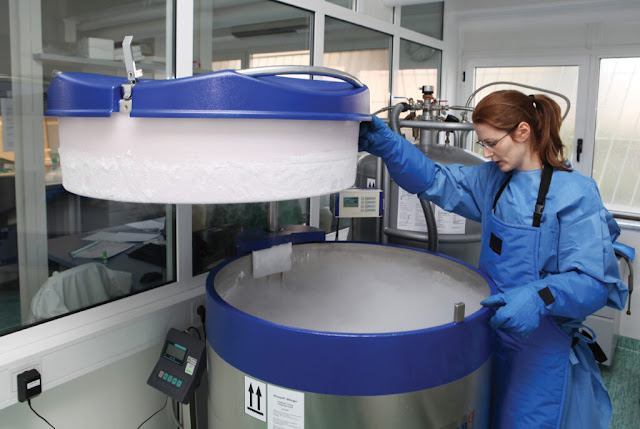 |
| Cryopreservation Equipment |
Cryopreservation refers to the process of preserving living biological materials such as human tissue, organs, embryos and even entire organisms at very low sub-zero temperatures using specialized cryopreservation equipment. At such low ultra-cold temperatures, any biological activity including chemical reactions and growth of microbes is effectively stopped, allowing long-term storage and preservation of specimens that would otherwise deteriorate much more rapidly at higher warmer temperatures. Cryopreservation has enabled life-changing scientific advances and applications across several fields such as medicine, biomedical research, agriculture and conservation biology. In this article, we discuss some of the key developments, applications and the sophisticated equipment required for cryopreservation.
Types of Cryopreservation Equipment
There are different types of cryopreservation equipment used depending on the biological specimens and intended application. For short to mid-term storage of small tissue/cell samples, mechanical freezers that can reach temperatures around -80°C are commonly used. For long-term preservation and archiving, vapor phase storage systems that use cryogen such as liquid nitrogen are employed. These systems maintain temperatures below -140°C.
Specialized Cryopreservation Equipment includes programmable controlled rate freezers that slowly cool samples at a controlled rate to minimize ice crystal formation. Manual or automated liquid nitrogen freezers are used for cryopreserving larger tissue/organ samples or embryos through direct contact with cryogen. Robotic arms are used in automated freezer units to load and retrieve samples safely without exposing them to warmer ambient temperatures.
A key component of most cryopreservation systems is the cryogenic liquid storage tank that maintains a steady supply of cryogen like liquid nitrogen. Advanced cryopreservation facilities use large liquid nitrogen storage tanks ranging from thousands of liters to tens of thousands of liters depending on their requirements and sample inventory size. Computer monitoring and alarm systems are integrated to track critical parameters like liquid nitrogen levels, temperatures and provide alerts in case of any deviations.
Applications in Medicine
Cryopreservation has revolutionized fields like fertility treatment, organ transplantation and regenerative medicine. Fertility clinics routinely cryopreserve sperm, egg and early embryo samples to aid infertility treatment and allow people to conceive much later. As per reports, there are over 1 million frozen embryos stored globally. Stem cells collected from umbilical cord blood, adipose tissue or extracted from teeth are also widely cryopreserved for potential future medical applications.
Successful transplantation of cryopreserved organs has become possible with improvements in cryopreservation techniques and equipment. Kidneys, livers and even pancreas can now be transported long-distances after retrieval and undergo transplantation with good outcomes. This significantly expands the donor pool. Skin tissue banks use cryopreservation to store skin grafts that are used extensively for burn patients and wound coverage. Cryopreservation also allows long-term storage of biopsies, blood and cell lines critical for medical research.
Applications in Biobanking and Research
Biobanks involved in collection, processing and long-term preservation of human biological samples and associated clinical data for research purposes heavily rely on robust cryopreservation infrastructure and equipment. Samples include blood, serum, plasma, urine, DNA, RNA along with entire tissue sections obtained from surgeries. Large scale biobanks typically install walk-in vaults outfitted with racks and shelves able to hold hundreds of thousands of cryovials in the vapor phase of liquid nitrogen.
Cryopreservation is integral to establish cell lines and cultures that drive the exponential growth of cell-based research areas like cancer biology, neuroscience, stem cell therapeutics development. Research institutions are actively developing better cryopreservation protocols and equipment to improve post-thaw viability of different cell types including stem cells, hepatocytes and more. Some specialized cryopreservation equipment catering to 3D tissue and organoid samples are also available now.
Agricultural and Conservation Applications
In agriculture, cryopreservation plays a crucial role in long-term conservation of plant genetic resources and breeding germplasm for future use. Plant seeds, pollen, somatic embryos, shoots/axillary buds from several commodity and rare crop varieties are cryopreserved in gene banks globally. This allows preservation of genetic diversity, and recovery/regeneration of entire plant varieties that may be extinct in nature.
Zoos and wildlife sanctuaries also rely on cryopreservation equipment to archive genetics of endangered species populations facing threats in wild through cryopreservation of sperm, oocytes and early embryos from unique genetic bloodlines. Future advancement of cloning and reproductive technologies could facilitate assisted reproduction using banked genetic samples. Cryopreservation also aids reintroduction programs for conservation of habitats.
As new innovative applications emerge, demand for advanced cryopreservation equipment customized for different biological sample types and applications will grow. Continued progress in controlling ice formation, additives development and protocols will improve post-thaw sample viability. Automated integrated cryopreservation systems providing end-to-end solution from sample intake to archiving are the future. Widespread adoption promises to unlock full potential of regenerative medicine while aiding agriculture, research institutes and conservation efforts globally. Cryopreservation is truly transforming modern biomedical sciences.
Get More Insights On This Topic: Cryopreservation
Equipment
Explore More Related Topic: In-Flight
Wi-Fi
